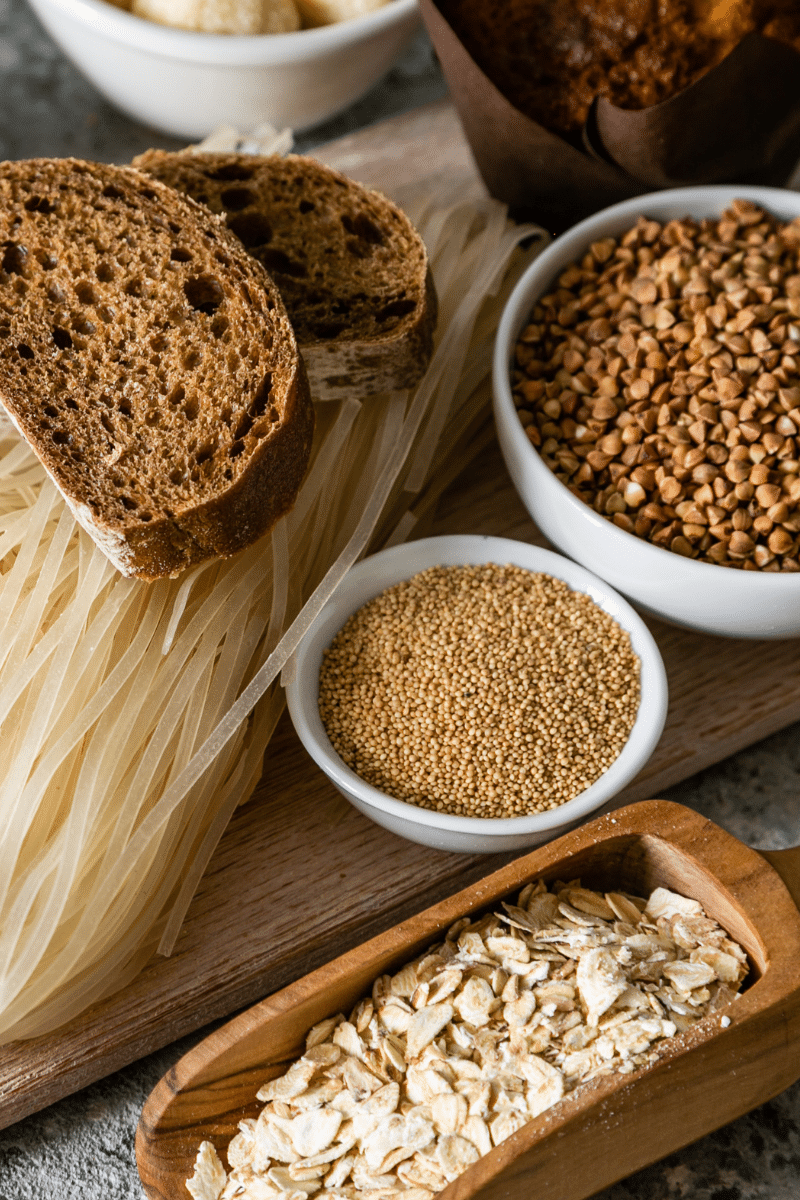March 25th, 2024
Simple vs. Complex Carbs: What’s the Difference?
“Carbohydrates provide essential nutrients and are one of the main sources of calories for our bodies” (American Heart Association, 2023). However, not all carbs are created equal. They can be broadly organized into two categories: simple and complex carbohydrates. Understanding the differences between these categories is key to making smart dietary choices, especially when it comes to fueling in-home personal training sessions, virtual workouts, trips to the gym – or life in general.
Comparing simple and complex carbs
SIMPLE CARBS
Simple carbohydrates, AKA sugars, are typically found in fruits (fructose), milk (lactose), baked goods, and sweets (sucrose). These carbohydrates are rapidly digested and absorbed by the body, leading to a spike in blood sugar levels. This can provide a quick source of fuel and energy, i.e. eating a banana or sipping a Gatorade during prolonged workouts or sports.
Simple carbs can also be handy to consume immediately after a workout in order to quickly facilitate the recovery process. However, it’s important to remember that a spike is often followed by a crash, leaving you feeling tired and hungry shortly after consumption. Because of this, simple carbs are often criticized for their lack of nutritional value beyond providing energy. Consuming excessive amounts of simple sugars can also contribute to weight gain, tooth decay, and an increased risk of type 2 diabetes and heart disease.
COMPLEX CARBS
In contrast to simple carbohydrates, complex carbohydrates take longer to break down and digest. This results in a more gradual release of glucose to the bloodstream, providing sustained energy over an extended period. This steady supply of energy helps to sustain your blood sugar levels and energy throughout in-home personal training and virtual workouts, allowing for longer and more intense sessions without fatigue. Complex carbs are also rich in fiber, vitamins, and minerals, making them a more nutritious choice for overall health. Some examples of foods rich in complex carbohydrates include: whole grains like brown rice, quinoa, oats, and whole wheat bread, legumes like beans, lentils, and chickpeas, or starchy veggies like sweet potatoes, corn, and peas. Incorporating more complex carbohydrates into your diet can support weight management, improve heart health, and reduce your risk of chronic diseases.
THE GLYCEMIC INDEX
The glycemic index (GI) is a measure of how quickly carbohydrates raise your blood sugar levels after consumption. Foods with a high glycemic index are typically simple (rapidly
digested and absorbed), leading to a sharp increase in blood glucose levels. Foods with a low glycemic index are typically complex (digested slowly), resulting in a gradual and sustained rise in blood sugar. Understanding the GI can help you manage your blood sugar levels, which is especially important for individuals with diabetes or those seeking to manage their weight. Prioritizing complex carbs with a lower glycemic index can promote stable blood sugar while reducing your risk of diseases associated with blood sugar fluctuations.
TOP TIPS
When it comes to in-home personal training (or your workouts in general), your preferences, tolerance, and specific fitness goals will ultimately dictate the appropriate timing and type of carbs you should consume. Experimenting with different strategies and paying attention to how your body responds can help determine the most effective approach. That said, here are a few tips for success:
- Pre Workout: Simple carbs before high-intensity or endurance activities can provide a quick source of energy: fruit, energy gels like GU, or sports drinks like Gatorade can top up glycogen stores and provide readily available fuel. Complex carbs pre-exercise are beneficial for providing sustained energy throughout a workout. These foods should be consumed 1-2 hours before activity to ensure proper digestion and a steady release of glucose.
- During Exercise: Consuming simple carbs during activity is necessary for prolonged workouts (longer than 60-90 minutes) to maintain blood sugar levels and provide quick energy. This is especially beneficial for exercises like long-distance running, cycling, or swimming. While complex carbs are not typically consumed during exercise due to their slower digestion rate (the fibre can upset your stomach), some endurance activities may benefit from small amounts of complex carbs during extended breaks. Whole-grain energy bars or sandwiches can provide a mix of carbs, protein, and fats to sustain energy without causing gastrointestinal discomfort.
- Post Workout: Simple carbs immediately after intense exercise (along with protein) can help to facilitate glycogen replenishment and muscle recovery quickly. White bread, rice cakes, or fruit can be paired with a protein shake or Greek yogurt to kick-start the healing process. Complex carbs post-workout are essential for replenishing glycogen stores and supporting healthy recovery. Pairing complex carbs like quinoa or whole grain pasta with protein within 30-60 minutes after exercise is ideal.
FINAL WORDS
While both simple and complex carbohydrates play a role in providing energy, their impact on your health varies significantly. Opting for complex carbs can provide sustained energy and essential nutrients while minimizing the negative effects associated with excessive simple sugar consumption.
“Understanding how these foods are classified and how they work in your body can help you choose the right carbs” (Healthline, 2023). Virtual and in-home personal trainers are licensed to provide basic nutritional guidance to support your fitness goals and overall health. If you’re unsure of some of the dietary choices you’re making, we can help! First workouts are zero pressure and always free. Book yours here.

